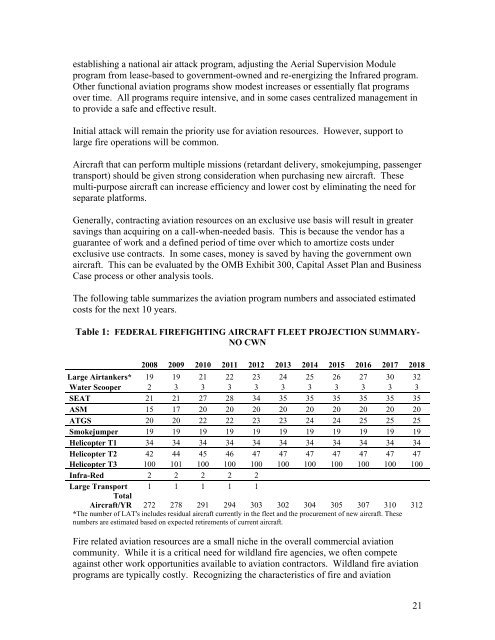Interagency Aviation Strategy - July 2008 - National Wildfire ...
Interagency Aviation Strategy - July 2008 - National Wildfire ...
Interagency Aviation Strategy - July 2008 - National Wildfire ...
You also want an ePaper? Increase the reach of your titles
YUMPU automatically turns print PDFs into web optimized ePapers that Google loves.
establishing a national air attack program, adjusting the Aerial Supervision Module<br />
program from lease-based to government-owned and re-energizing the Infrared program.<br />
Other functional aviation programs show modest increases or essentially flat programs<br />
over time. All programs require intensive, and in some cases centralized management in<br />
to provide a safe and effective result.<br />
Initial attack will remain the priority use for aviation resources. However, support to<br />
large fire operations will be common.<br />
Aircraft that can perform multiple missions (retardant delivery, smokejumping, passenger<br />
transport) should be given strong consideration when purchasing new aircraft. These<br />
multi-purpose aircraft can increase efficiency and lower cost by eliminating the need for<br />
separate platforms.<br />
Generally, contracting aviation resources on an exclusive use basis will result in greater<br />
savings than acquiring on a call-when-needed basis. This is because the vendor has a<br />
guarantee of work and a defined period of time over which to amortize costs under<br />
exclusive use contracts. In some cases, money is saved by having the government own<br />
aircraft. This can be evaluated by the OMB Exhibit 300, Capital Asset Plan and Business<br />
Case process or other analysis tools.<br />
The following table summarizes the aviation program numbers and associated estimated<br />
costs for the next 10 years.<br />
Table 1: FEDERAL FIREFIGHTING AIRCRAFT FLEET PROJECTION SUMMARY-<br />
NO CWN<br />
<strong>2008</strong> 2009 2010 2011 2012 2013 2014 2015 2016 2017 2018<br />
Large Airtankers* 19 19 21 22 23 24 25 26 27 30 32<br />
Water Scooper 2 3 3 3 3 3 3 3 3 3 3<br />
SEAT 21 21 27 28 34 35 35 35 35 35 35<br />
ASM 15 17 20 20 20 20 20 20 20 20 20<br />
ATGS 20 20 22 22 23 23 24 24 25 25 25<br />
Smokejumper 19 19 19 19 19 19 19 19 19 19 19<br />
Helicopter T1 34 34 34 34 34 34 34 34 34 34 34<br />
Helicopter T2 42 44 45 46 47 47 47 47 47 47 47<br />
Helicopter T3 100 101 100 100 100 100 100 100 100 100 100<br />
Infra-Red 2 2 2 2 2<br />
Large Transport 1 1 1 1 1<br />
Total<br />
Aircraft/YR 272 278 291 294 303 302 304 305 307 310 312<br />
*The number of LAT's includes residual aircraft currently in the fleet and the procurement of new aircraft. These<br />
numbers are estimated based on expected retirements of current aircraft.<br />
Fire related aviation resources are a small niche in the overall commercial aviation<br />
community. While it is a critical need for wildland fire agencies, we often compete<br />
against other work opportunities available to aviation contractors. Wildland fire aviation<br />
programs are typically costly. Recognizing the characteristics of fire and aviation<br />
21
















